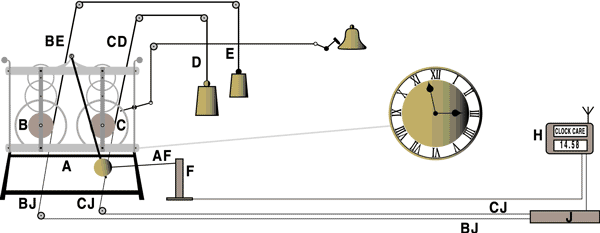1. Pendulum catcher
The pendulum catcher F holds the pendulum A in its outermost position by means of the wire AF. At the same time, in the column F (indirect via the wire AF) the swing of the pendulum A is measured and the number of swings is counted.
2. Winder
The winder J pulls the weights E and D up by means of the lines BJ and CJ. These are attached to the ropes BE and CD and wound around the barrels B and C in the movement itself.
3. Computer
The computer H controls, checks, and registers the operation of the pendulum catcher F and the winder J. The electronic clock in the computer is calibrated based on absolute time using the radio signal DCF-77.
For
the purpose of simplicity, the example involves a movement with striking
work that is wound every hour and that has a seconds’ pendulum. This
means that one beat equals one second, and after 3600 beats the minute
hand will have made one full revolution.
Operation
1.
The
pendulum is set in such a way that the clock runs about five seconds per
hour ahead.
2. After
3600 beats, the pendulum A is held
in its outermost position by the pendulum catcher
F via the wire AF. The
movement now stops and the escapement of the going train is blocked by
the sideways position of the pendulum.
3. Because
the clock is running ahead of time, the winder J
has time to pull up weight D of the
going train B and weight E
of the striking train by means of the lines BJ
and CJ.
Winding the clock takes approximately 4 seconds, and is preferably performed
two minutes before the hour in order to guarantee proper functioning of
the striking work.
4. The
computer ensures that the pendulum catcher F
does not let go of the pendulum A
until the time on the old clock is exactly the same as the absolute time
in the computer.
5. Now
the clock runs for 3600 beats and the cycle starts again at step 1.
